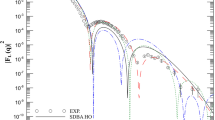Abstract
The ground state binding energies of the light symmetric closed-shell nuclei, i.e., 4He, 12C, 16O and 40Ca and the heavy asymmetric ones, i.e., 48Ca, 90Zr and 120Sn are calculated in the harmonic oscillator (HOS) basis, by imposing the relative Fermi momentum cutoff of two point-like interacting nucleons on the density dependent average effective interactions (DDAEI). The DDAEI are generated through the lowest order constrained variational (LOCV) method calculations for the asymmetric nuclear matter with the operator and the channel dependent type bare nucleon-nucleon potentials, such as the Argonne \(Av_{18}^{j_{\max } = 2}\) and the Reid soft core, Reid68, interactions. In the framework of harmonic oscillator shell model, the cutoff is imposed by defining the maximum value of the relative quantum numbers (RQNmax) in two ways: (1) The RQNmax of the last shell and (2) the RQNmax of each shell, in the ground state of the nucleus. It is shown that present results on the binding energies and the root means square radius are closer to the corresponding experimental data than, our previous works with the same DDAEI potentials, but without the cutoff constraint. However, for the light symmetric nuclei, the second scheme gives less binding energy and larger root mean square radius compare to the first one. While the situation is reversed for the heavier nuclei.
Similar content being viewed by others
References
H. A. Bethe, “Theory of nuclear matter,” Ann. Rev. Nucl. Part. Sci. 21, 93 (1971).
J. G. Zabolitsky and W. Ey, “Momentum distributions of nucleons in nuclei,” Phys. Lett., Ser. B 76, 223 (1977).
V. R. Pandharipande, I. Sick, and P. K. A. Huberts, “Independent particle motion and correlations in Fermion systems,” Rev. Mod. Phys. 69, 981 (1997).
J. C. Owen, R. F. Bishop, and J. M. Irvine, “Constrained variation in Jastrow method at high density,” Ann. Phys. (NY) 102, 170 (1976).
M. Modarres and J. M. Irvine, “LOCV calculations with a self-consistent treatment of isobars,” J. Phys., Ser. G 5, 511 (1979).
M. Modarres and G. H. Borbar, “Incompressibility of hot asymmetrical nuclear matter: lowest order constrained variational approach,” Phys. Rev., Ser. C 58, 2781 (1998).
K. A. Brueckner, C. A. Levinson, and H. M. Mahmoud, “Two-body forces and nuclear saturation, I: Central forces,” Phys. Rev. 95, 217 (1954).
K. A. Brueckner and C. A. Levinson, “Approximate reduction of the many-body problem for strongly interacting particles to a problem of self-consistent fields,” Phys. Rev. 97, 1344 (1955).
J. W. Negele, “Structure of finite nuclei in the local-density approximation,” Phys. Rev., Ser. C 1, 1260 (1970).
R. V. Reid, “Local phenomenological nucleon-nucleon potentials,” Ann. Phys. 50, 411 (1969); B. D. Day, “Three-body correlations in nuclear matter,” Phys. Rev., Ser. C 24, 1203 (1981).
A. M. Green, J. A. Niskanan, and M. E. Sainio, “The effect of the delta (1236) on the imaginary component of nucleon-nucleon phase-shifts,” J. Phys., Ser. G 4, 1055 (1978).
R. B. Wiringa, V. G. J. Stocks, and R. Schiavilla, “Accurate nucleon-nucleon potential with charge-independence breaking,” Phys. Rev., Ser. C 51, 38 (1995).
M. Modarres and N. Rasekhinejad, “The effective potential and local density approximation approach to the binding energy of closed shell nuclei,” Phys. Rev., Ser. C 72, 014301 (2005).
M. Modarres and N. Rasekhinejad, “Ground state of heavy closed shell nuclei: an effective interaction and local density approximation approach,” Phys. Rev., Ser. C 72, 064306 (2005).
M. Modarres, N. Rasekhinejad, and H. Mariji, “The density-dependent AV18 effective interaction and ground state of closed shell nuclei,” Int. J. Mod. Phys., Ser. E 20(3) (2011).
M. Modarres, H. Mariji, and N. Rasekhinejad, “The effect of density dependent AV18 effective interaction on the ground state properties of heavy closed shell nuclei,” Nucl. Phys., Ser. A 859, 16 (2011).
M. Modarres and H. Mariji, “The effect of non-diagonal two-body matrix elements on the binding energy of closed shell nuclei,” Phys. Rev., Ser. C 86, 054324 (2012).
M. Modarres, “Local density approximation for alpha-particle binding energy,” J. Phys., Ser. G 10, 251 (1984).
M. Modarres, H. R. Moshfegh, and H. Mariji, “Lowest order constrained variational and local density approximation approach to the hot alpha particle,” Can. J. Phys. 80, 911 (2002).
L. Coraggio, N. Itaco, A. Covello, et al., “Ground-state properties of closed-shell nuclei with low-momentum realistic interactions,” Phys. Rev., Ser. C 68, 034320 (2003).
L. Coraggio, A. Covello, A. Gargano, et al., “Nuclear Structure calculations and modern nucleon-nucleon potentials,” Phys. Rev., Ser. C 71, 014307 (2005).
L. Coraggio, A. Covello, A. Gargano, et al., “Nuclear structure calculations with low-momentum potentials in a model space truncation approach,” Phys. Rev., Ser. C 73, 014304 (2006).
Author information
Authors and Affiliations
Corresponding author
Additional information
The article is published in the original.
Rights and permissions
About this article
Cite this article
Mariji, H., Modarres, M. The effect of Fermi momentum cutoff on the binding energy of closed shell nuclei in the LOCV framework. Phys. Part. Nuclei Lett. 11, 245–251 (2014). https://doi.org/10.1134/S1547477114030133
Published:
Issue Date:
DOI: https://doi.org/10.1134/S1547477114030133



